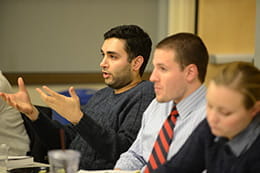In the Department of Physical Medicine & Rehabilitation (PM&R) at Indiana University School of Medicine, physician educators provide an excellent educational experience to medical students, residents and fellows as they pursue careers in physiatry.
Career Preparation
Physicians in this specialty care for individuals of all ages who have conditions of the bones, muscles, joints, brain and nervous system, and they help to restore the patient’s function and quality of life to the fullest extent possible. Physiatrists commonly treat sports- and work-related injuries, trauma of all types, and diseases and disorders, including stroke, Parkinson’s disease, cerebral palsy and multiple sclerosis.
Training in Physical Medicine and Rehabilitation offers opportunities for careers in academic, hospital-based or private practice settings. Clinical as well as administrative positions are available, and many practitioners enjoy a balance between inpatient and outpatient work. Advancing technologies in patient care also make physiatry an exciting specialty in which to conduct research.

